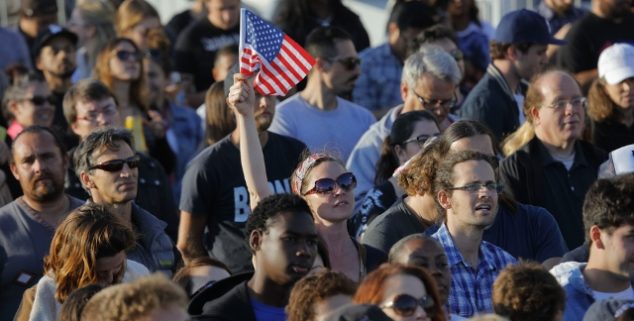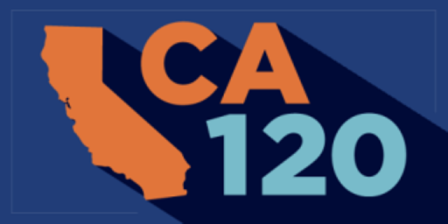News
CA120: Get ready for the 2018 election reforms
 The crowd at a 2016 political rally in Santa Monica. (Photo: Joseph Sohm)
The crowd at a 2016 political rally in Santa Monica. (Photo: Joseph Sohm)One of the ongoing themes in analyzing California’s 2018 elections is the impact of the reforms that were enacted in 2012 – the state’s open primary, the extension of term limits and the new district lines drawn by the state’s independent redistricting commission.
Beyond these three, we also saw the creation of statewide online voter registration and a ballot measure to allow passage of an on-time state budget by a simple majority vote.
This wave of reforms has made it incredibly difficult to discern the impact of each. You often see them being conflated in analyses of the state’s elections and governance.
For example, can you claim that stability in the Legislature is a result of redistricting reform and the election of more moderate legislators, when there is no actual evidence of that? Can you claim that Sacramento is more highly functioning because of the open primary, when that efficiency is more attributable to the extension of term limits or a lower-vote threshold for passing a budget?
Multiple reforms, all at the same time.
And in 2018 we are at it again.
For this June primary, we are about to witness the impact of four different election reforms that are intended to increase registration, improve turnout and remove hurdles on Election Day.
Already enacted is a reform that allows 16- and 17-year-olds to pre-register, then become an active voter registrant on their 18th birthday. This reform has been subject to much interest, particularly with the stories of increased political engagement by young people in the Trump era and after the Parkland shooting.
Impact? We are already seeing a reported 100,000 pre-registrations being reported by the Secretary of State’s office. How many of these voters ultimately will turn out is unclear.
In June, the state will be finally implementing a same-day registration law that has been on the books for more than six years, but was hung up by years of delays
The next reform will be here on April 16. That’s when the Department of Motor Vehicles changes the procedure by which it registers voters. For years, California residents who were over 18 and citizens would be asked at the DMV if they would like to register to vote under the state’s “Motor Voter” law.
Eligible voters would be given a form, and they could complete their registration there or they could go home to finish it and mail it in. In the current voter file, there are 2.1 million Californians who were registered by the DMV (or through another state agency), including more than 225,000 in 2017 alone.
Under the new policy, the DMV makes a U-turn.
Instead of asking a voter if they want to register, and having them opt-in with a form, they will now be informed that they will be automatically registered unless they opt-out. For someone who rushed to get out of an overcrowded DMV office in 2017, not registering would have been the easiest course. But, going forward, allowing the registration to be completed would be the best “get-out-of-the-DMV-fast” strategy.
Impact? It is projected that we will see more 2 million new registrants with this small change to the Motor Voter law. This could push the state’s total registration to over 22 million. But, we also know that the DMV registrants are lower turnout – in the 2016 General these voters were 74% turnout compared to 81% for voters who registered online.
If someone doesn’t register to vote when they’re 16 or 17, or fails to get into a DMV before June, there will be yet another reform waiting for them.
In June, the state will be finally implementing a same-day registration law that has been on the books for more than six years, but was hung up by years of delays. This version of same-day registration, technically called “conditional registration” allows any Californian to register and vote either at a county registrar office, or a satellite, in the last 15 days before or on Election Day.
The “conditional registration” is completed, the voter can cast a ballot, and both are embargoed until the county can verify that the voter is eligible, and didn’t vote anywhere else in the state.
Up to 14 counties were allowed to convert to this system but only five took the bait: Sacramento, San Mateo, Madera, Napa and Nevada.
Impact? It is really unknown how this version of same-day registration will unfold. It won’t be like the famous same-day registration law in Minnesota, which resulted in a swarm of new unexpected voters and elected Jesse Ventura, because California voters can’t do same-day registration at every precinct. But it does mean that campaigns can continue to target unregistered eligible voters all the way to Election Day.
A big question mark will be how aggressively counties assign satellite offices that can perform the registration. (Speaking as someone born and raised in Los Angeles, you couldn’t get me to drive all the way to Norwalk just to vote in a primary election.)
That’s three reforms at once. But we’ve saved the biggest one for last.
Lawmakers recently authorized a major election reform which would shutter the traditional Election Day precincts, and instead mail ballots to all voters. In place of precincts, counties would establish a number of vote centers that would be open 10 days preceding each election, and the number of centers would grow three-days out.
One real benefit of this system is that voters can go to any vote center in the county to return their vote-by-mail ballot or get a replacement. Any vote center in the county would be able to produce an on-demand ballot which includes all the local contests and measures for that voter – a vast improvement over the current “provisional” ballots used heavily in recent years.
Up to 14 counties were allowed to convert to this system but only five took the bait: Sacramento, San Mateo, Madera, Napa and Nevada. Other counties appear to have balked at the change, including a surprise move in Orange County, despite the fact that their county registrar was one of the leaders in the change and helped draft the law.
Will campaigns start talking to today’s 16- and 17-year-olds, and pushing them to register now, while their political interest is high? Will campaigns be pushing their supporters to get same-day registrations?
The system isn’t brand new, as San Mateo conducted an election in this manner in 2015 and Colorado has converted entirely to this system of elections, with positive results.
In 2020 all California counties will be able to convert to this new system provided they can meet the state requirements – but for now eyes will be on these five counties to see how the new system works.
Impact? My analysis of the 2015 San Mateo experiment showed increased turnout, particularly among younger and more minority voters. However this was after a significant marketing campaign, and with ballots which were postage-paid (saving millennials from having to figure out where they keep their stamps.) And moving the needle a bit in an extremely low-turnout odd-year municipal election might not really predict what will happen with a broader expansion in a statewide election cycle, particularly when it is such a major departure from how half of the electorate are used to casting ballots.
While these reforms all have their potential to improve elections, one of the most important factors will be how campaigns and the state’s political consultants adjust their strategies.
Will campaigns start talking to today’s 16- and 17-year-olds, and pushing them to register now, while their political interest is high? Will campaigns be pushing their supporters to get same-day registrations? Will campaigns see the growth in DMV registrants as an expansion of their targeting, or will they be dismissed as unlikely voters?
And, in the counties with vote centers, how will campaigns push voters to the polls when the polling places aren’t really there anymore – replaced by mail-in ballots and vote centers with a wider window of time for getting out the vote?
All of this will be closely watched.
And, in the years to come, we will have the nearly impossible task of unpacking the results, trying to figure out which reform had which impact, and what policies and changes can continue to help achieve the goals of a safe, secure, high participation election system.
—
Ed’s Note: Paul Mitchell, a regular contributor to Capitol Weekly, is the creator of the CA120 column, vice president of Political Data and owner of Redistricting Partners, a political strategy firm.
Want to see more stories like this? Sign up for The Roundup, the free daily newsletter about California politics from the editors of Capitol Weekly. Stay up to date on the news you need to know.
Sign up below, then look for a confirmation email in your inbox.

“we will see more 2 million new registrants with this small change to the Motor Voter law.”
Right… 2 million more illegal aliens.